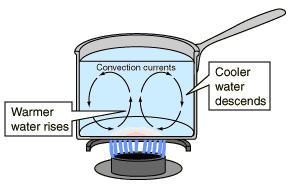Both of your friends are correct.
Well done Abhinav and Saksham. Keep posting. THUMBS UP TO BOTH OY YOU.
- 3
Convection currents in liquids
When a vessel containing a liquid is heated at the bottom a current of hot liquid moves upwards and its place is taken by a cold current moving downwards. Unlike conduction, where heat is passed on from one section of the substance to another as described in the previous post ( transmission of heat energy explained), the heat is here actually carried from one place to another in the liquid by the movement of the liquid itself. This phenomenon is called convection. The same process occurs when a gas is heated.
Experiment to demonstrate convection currents in water
| Convection currents in water |
Convection currents in water may be shown by filling a large spherical flask with water and dropping a single large crystal of potassium permanganate ( KMnO4) to the bottom of it through a length of glass tubing. A finger is placed over the end of the tube, which is then removed, together with the colored water it contains.
After a short time it circulates down the sides of the flask, showing that a convection current has been set up.
Explanation of convection currents
When a portion of liquid near the bottom of a vessel is heated it expands. Since its mass remains unaltered, it becomes less dense ( you remember that Density = mass / volume ), and therefore rises. Thus a warm convection current moves upwards; for the same reason a cork rises in water or a hydrogen-filled balloon rises in air. In effect, convection is an application ofArchimedes' principle. For further illustration please read Balloons and floating bodies.
- 1
When a vessel containing a liquid is heated at the bottom a current of hot liquid moves upwards and its place is taken by a cold current moving downwards. Unlike conduction, where heat is passed on from one section of the substance to another as described in the previous post ( transmission of heat energy explained), the heat is here actually carried from one place to another in the liquid by the movement of the liquid itself. This phenomenon is called convection. The same process occurs when a gas is heated.

- 0
When a vessel containing a liquid is heated at the bottom a current of hot liquid moves upwards and its place is taken by a cold current moving downwards. Unlike conduction, where heat is passed on from one section of the substance to another as described in the previous post ( transmission of heat energy explained), the heat is here actually carried from one place to another in the liquid by the movement of the liquid itself. This phenomenon is called convection. The same process occurs when a gas is heated.
You can also add pottasium permangnate crystals to see the flow of convection
- 2

